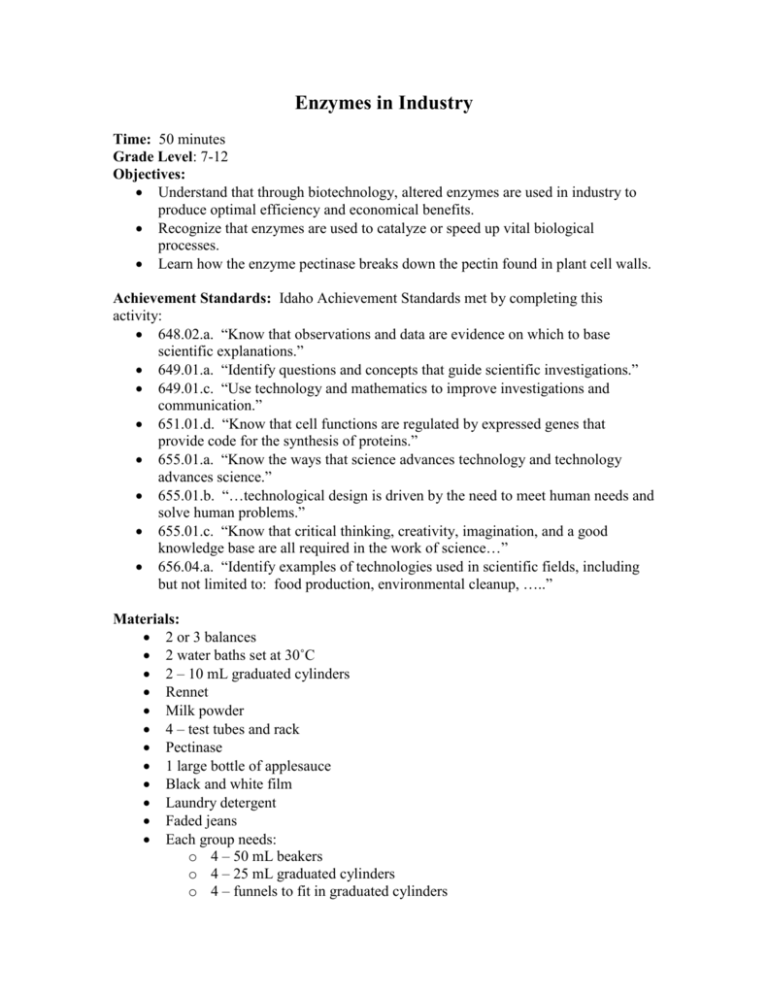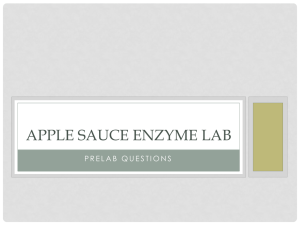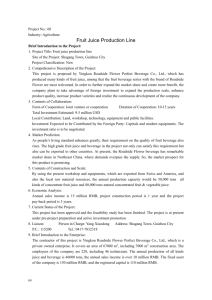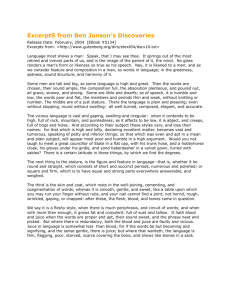Lesson Plan in Word Format
advertisement

Enzymes in Industry Time: 50 minutes Grade Level: 7-12 Objectives: Understand that through biotechnology, altered enzymes are used in industry to produce optimal efficiency and economical benefits. Recognize that enzymes are used to catalyze or speed up vital biological processes. Learn how the enzyme pectinase breaks down the pectin found in plant cell walls. Achievement Standards: Idaho Achievement Standards met by completing this activity: 648.02.a. “Know that observations and data are evidence on which to base scientific explanations.” 649.01.a. “Identify questions and concepts that guide scientific investigations.” 649.01.c. “Use technology and mathematics to improve investigations and communication.” 651.01.d. “Know that cell functions are regulated by expressed genes that provide code for the synthesis of proteins.” 655.01.a. “Know the ways that science advances technology and technology advances science.” 655.01.b. “…technological design is driven by the need to meet human needs and solve human problems.” 655.01.c. “Know that critical thinking, creativity, imagination, and a good knowledge base are all required in the work of science…” 656.04.a. “Identify examples of technologies used in scientific fields, including but not limited to: food production, environmental cleanup, …..” Materials: 2 or 3 balances 2 water baths set at 30˚C 2 – 10 mL graduated cylinders Rennet Milk powder 4 – test tubes and rack Pectinase 1 large bottle of applesauce Black and white film Laundry detergent Faded jeans Each group needs: o 4 – 50 mL beakers o 4 – 25 mL graduated cylinders o 4 – funnels to fit in graduated cylinders o o o o o o o o o o o Filter paper for funnels 1 dropper 1 marker pencil 1 stirring rod 1 whole fruit per group (mango, pear, avocado, strawberry, grape, peach, orange) Whatever whole fruit is used per group, have enough fruit puree of that same fruit to equal 100 g of puree. Petri dish Graph transparency Experiment outline Data sheet Homework assignment Preparation: Before the lesson boil the fruit (if fruit requires) for 5 minutes and blend in a blender until it reaches the consistency of applesauce. Keep the fruit puree in the refrigerator. Dilute the Pectinase with 2 parts water to 1 part Pectinase. Prepare “Enzymes, Jacks of all Trades in Nature and Industry” table. This includes the faded jeans, black and white film, laundry detergent and curds and whey. To produce curds and whey dilute 5 g of milk powder into 50 mL water. Dispense 10 mL of the milk solution into 4 test tubes. Dilute rennet by mixing 1 mL rennet with 9 mL of water. Add 0.1, 0.5, and 1 mL of the diluted rennet to three of the test tubes and label accordingly. Use the fourth tube as the control. Place in a water bath at 30C for 30 min. Class Outline Introduction: Give each group a different piece of fruit. Have them squeeze, smash, press… whatever it would take to get as much juice as possible out of their fruit. Have the juice go into the Petri dish. Ask them “what are some other ways to get juice out of fruit? If you were to open a fruit juice stand, what would be the most efficient way for you to produce juice? How do you think industries produce mass quantities of juice? How do you think the juice we buy in the grocery store is made?” After discussing, switch gears for a moment and ask them “Who can tell me what an enzyme does? Do you think we can use an enzyme to help us produce juice? Let’s try it!” Discussion: Review what is found in the cell wall of plant cells--pectin. Tell them that pectin is what we pour in blended fruit or juice to make jam or jelly. The pectin causes the juice to be retained and trapped, causing the jam to thicken. Therefore, the pectin retains the water found in the cell walls. Then tell them the enzyme we are going to use in our fruit juice production is called Pectinase and see if they can guess what the enzyme might do. It dissolves the pectin found in the cell walls. Once the pectin is gone, all of the retained water is released to produce more fruit juice. Experiment: Begin the experiment by having them follow the experiment outline. For the rest of class run the experiment according to the outline. During the water bath have the students go to the “Enzymes, Jacks of all Trades in Nature and Industry” table. Display the curds and whey, laundry detergent, black and white film and faded jeans. Ask the students, “How many of you have a favorite pair of jeans? Why are they your favorite?” Explain to them that enzymes are used in industrial process for making textiles or jeans soft and smooth. Instead of stonewashing, they now use enzymes to fade our jeans. Next, explain that enzymes are found in laundry detergents. We used to wash our clothes in 70˚C water, now enzymes do the job at only 40˚C water. Reducing the temperature means greater savings of energy and money. The enzymes also replace chemicals found in the detergents. This helps in the reduction of chemical waste from both industrial and household laundry. Next, discuss how black and white film consists of a dispersion of silver halide in gelatin, found on the outside of the film. Used or outdated film contains a source of silver, which can be recovered and recycled with enzymes. Last, explain that enzymes are also found in the production of cheese. Show them the prepared curds and whey. The whey is poured off from the curds and the curds are allowed to mature to form cheese. An enzyme called rennet has the properties of clotting or curdling milk. The proteins (casein micelles) found in the milk are destabilized by the rennet and a precipitate, or curd is formed. Rennet is obtained from the stomachs of young mammals living on milk (usually calves). They are now able to produce their own rennet from microbial sources. The gene from the calf stomach cell which makes the cell produce the enzyme rennin is removed and inserted into a bacteria or yeast cell. A fun story to share is the legend of how cheese was “discovered”. Thousands of years BC, a traveler placed milk into a pouch made from sheep stomach. During the journey, the sun’s heat and the enzymes in the lining of the stomach pouch changed the milk into curds and whey. Discussion: At the conclusion of the lesson, ask the students, “If you were now going to open a fruit juice stand, after seeing the results, how would you produce the juice? What juice would you sell? Review the different ways of how enzymes can be used for optimal efficiency in industrial purposes. Hand out and discuss homework assignment. Name_______________________ Enzymes in Industry Experiment Outline 1. Into each of two beakers put 50 grams of applesauce and into each of two other beakers put 50 grams of your fruit (indicate your fruit type on the datasheet). Next, with your dropper, add 1 mL of water to one beaker of applesauce and to one beaker of the other fruit and thoroughly mix with stirring rod. To the other beaker of applesauce and fruit add to each 1 mL of Pectinase and thoroughly mix with stirring rod. Make sure to mark with the marking pencil which beakers have the Pectinase in them. 2. Place all four beakers in the water bath set at 30˚C for 15 minutes. 3. Between your two fruit mixtures with the Pectinase in, predict which one will produce the most juice. Why? 4. Why did we put the fruit puree in the water bath at 30˚C as opposed to a boiling water bath at 100˚C or an ice water bath at 0˚C? 5. What is the purpose of having a beaker full of puree and mixing it only with water? 6. When the 15 minutes is up, pour each mixture into its own separate funnel. Start timing immediately. At the indicated intervals on your data sheet, record the amount of juice collected for each mixture to the nearest mL. 7. Once all of the data is collected. Create a linear graph on the provided overhead paper for each the applesauce and the other fruit. Place the time on the x-axis and the juice received, in mL, on the y-axis. Make the applesauce juice a dashed line and the other fruit juice a solid line. 8. Using your overhead projector present your results to the class. Compare your results with the other members of the class. Data Sheet Time (Minutes) Applesauce Juice (mL) Control 1 3 6 9 12 15 Experimental Other Fruit Juice ___________________ (mL) Control Experimental Name_______________________ Enzymes in Industry Homework Assignment If you could have an enzyme help you in making your life more efficient, what would it do? Create your own personal enzyme to help catalyze a specific function in your life. Write a one paragraph description on your enzyme. You will need to name the enzyme, explain where it is found (like the rennet being found in a calves stomach), and how it is used to make your life more efficient. An example may be a homework enzyme. Remember though, the enzyme cannot perform the homework it can only help in speeding up the process.







